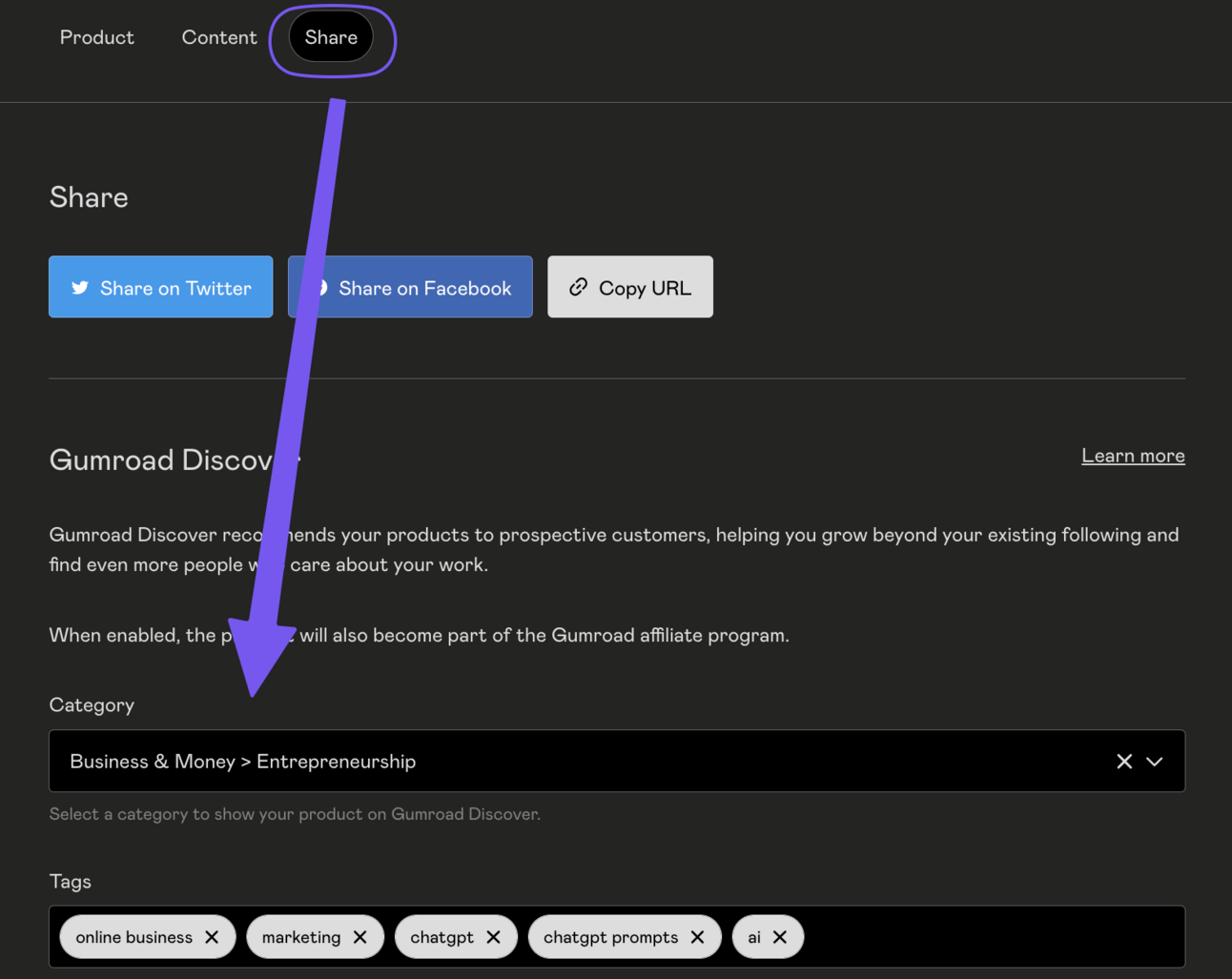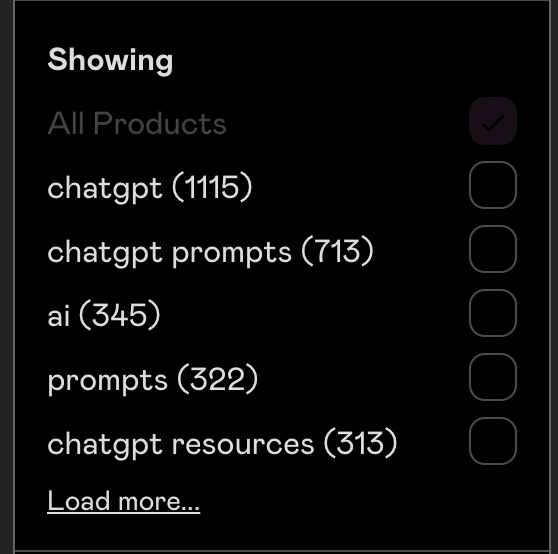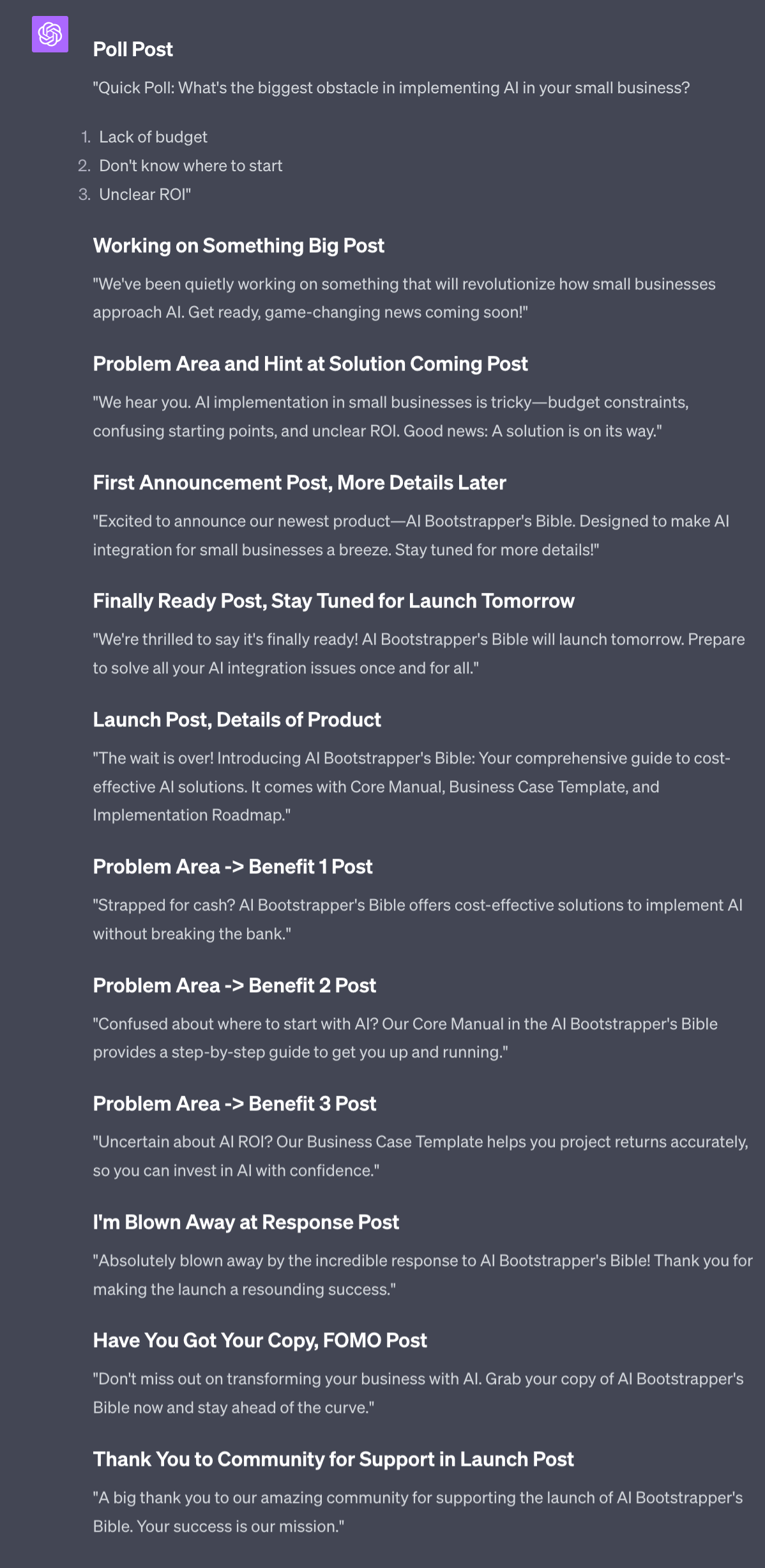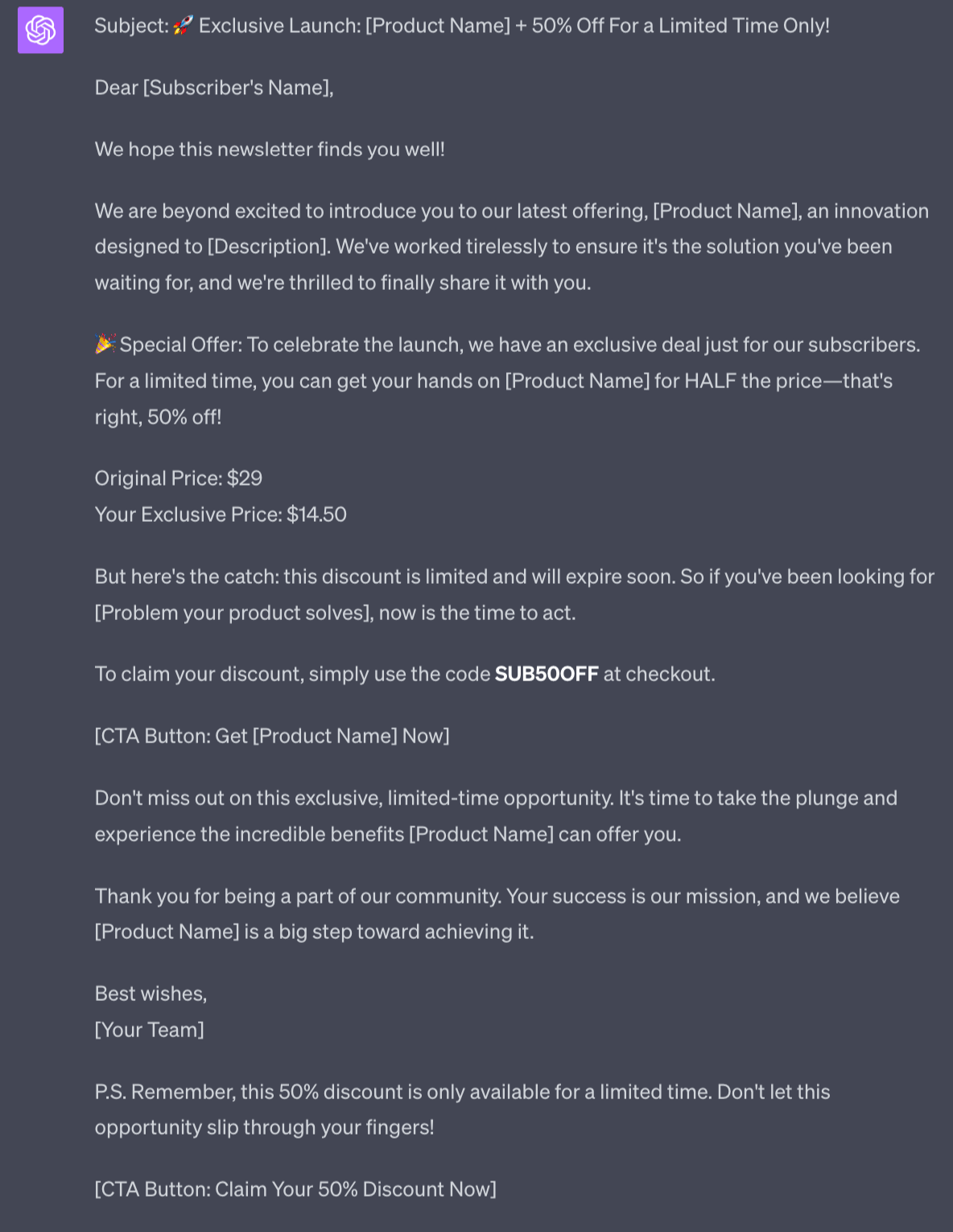Hey Prompt Entrepreneur,
In this Part we’re going to market and launch our product.
Making your first sale is a big deal in any online business.
In this Part we’ll look at a number of strategies for launching.
Let’s get started:
Market your digital product
1. Gumroad Discover
First up is a nice easy win.
Gumroad has its own marketplae where people can find and buy products.
Here’s a breakdown of one of my recent products:

Most traffic (230 views, 76 sales, 33% conversion) comes from Twitter/X which is not too surprising.
Further down “Recommended by Gumroad” is from Gumroad Discover.
That’s the second highest traffic channel with 177 views and 109 sales. Note also the high conversion at 61.6%.
Whilst Discover shouldn’t be your primary channel it’s definitely worth setting up for free traffic and sales.
Doing so is nice and simple.
In your product listing go to Share:

From here you can set the category and tags.
To get good categories and tags go to https://discover.gumroad.com/
For categories just browse using the top and side menu until you find a category that has similar products to yours. They should be similar topics, length and price if possible.
Once you’ve found your category check the top of the page. There will be a list of popular tags like this:

Go ahead and grab these tags.
If you can’t find your category try using search instead. Put in keywords connected to your product and see what comes up. Then locate what categories they are in.
Also in search check the left sidebar for tags:

Once you’ve set the category and tags your product will be visible on Discover. That’s step one.
But we also want to increase its visibility.
We do this by basically making Gumroad our affiliate – ie. we pay Gumroad a percentage of the product price in return for them featuring it!
Scroll down on the Share page and toggle the Boost button.

Notice you can also set the percentage you are willing to give Gumroad. This is up to you – the higher the fee the more they will boost.
So if have a $129 product and set fee at 100% Gumroad will take $129 in full. That incentives them to push the product hard. They’ll make it visible and secure sales for you.
Early on I recommend going hard on the fee – I’ll often set it at 100% just to make sales and start to generate reviews. You will make no cash from this of course so it needs to be considered a marketing expense.
Set the boost as high as you can to suit your business goals.
2. Social Media Launch
The second element of your launch should be using your social channels and the audience you’ve built up there. Having an existing audience makes gaining initial momentum during a launch much easier.
On social media you should run a campaign over the week or two before launch. Here is a prompt to construct your basic campaign:
Act as a social media marketing expert.
Draft me a series of posts to launch a new product.
The product's name is [name] and it is: [description]
The product contains [components]
It aims to solve these problems: [problem areas]
Create the following social media posts for me
- poll post that primes audience to think about problem areas whilst not mentioning product
- working on something big post
- problem area post and hint at solution coming post
- first announcement post, more details later
- finally ready post, stay tuned for launch tomorrow
- launch post, details of product
- problem area -> benefit 1 post
- problem area -> benefit 2 post
- problem area -> benefit 3 post
- I'm blown away at response post
- have you got your copy, FOMO post
- thank you to community for support in launch post
Make each post under 280 characters. Do not use hashtags. Do not use emojis. I go ahead and fill in the product name, description, problem areas from previous Parts.
💬 Prompt Output

ChatGPT now gives me a whole launch sequence for social media. I’ve crafted these as short Twitter/X messages – you can go longer if using LinkedIn or another platform but I’d recommend short and punchy.
Supplement these posts with your own – perhaps screenshots of the product, personal posts about why this is important to you and early review screenshots. Use your imagination to flesh out the skeleton posts that ChatGPT has given you.
3. Newsletter Launch
Launching to your Audience on social media is a wide, less focused approach. You may hit a big audience but they are less engaged with you and your work.
If you have a newsletter though this all changes. Your subscribers are your Tribe: people who have actively raised their hand and said “yes please I want to hear more from you.” They did this by first giving you their email address and then by continuing to open the newsletters you send them.
These people are more likely to become customers than those on social media.
Launching to your newsletter is a similar process of teasing, announcing and then reminding people.
But I like to also reward newsletter subscribers more than social media audience. You may have noticed in my newsletter I give away free books every-time I publish a new one. This is a way to say thank you and it boosts my early Amazon sales and reviews. Win-win.
You can do something similar with your Gumroad products by using discount codes.
You can make discount codes in Gumroad by:
- Click Checkout
- Click New Discount in top right
- Filling out the discount details
Set your discount to apply to just the new product. Choose how much of a discount to give your subscribers.
Optionally set a usage limit – this is a nice way to create scarcity. For instance if you have 5000 subscribers you might set a usage limit of 500 first come first served.
This will ensure that people actually bother to claim the discount. Otherwise maybe people will think “ah I’ll just do it later” and will invariably forget.
Once you have a discount set up add a section to an upcoming newsletter with an announcement. Here’s a nice simple prompt:
Act as an expert newsletter writer
Announce a new product and exclusive discount code to the subscribers.
The product is [name] and it is [description]
The normal price is [$] and the discount is [%]
Emphasise limited nature of discount to ensure action
💬 Prompt Output

Your announcement could be its own email (like this example) or combined into an existing newsletter – which is better depends on how often you normally contact your subscribers and also how “busy” you standard newsletters are.
4. Affiliate Launch
As well as launching sales directly to your social media and newsletter lists you should look at running an affiliate campaign in parallel.
Affiliate marketing is basically having other people recommend and help you secure sales and giving them a percentage of the sale.
For example I might charge $200 for a course and offer a 50% affiliate offer.
If someone shares information about my course and drives traffic to my sales page that converts into a sale then I pay them $100 per sale. I collect the remaining $100.
If they send me 10 sales they get $1000 and I get $1000.
Generally affiliate payouts are 30-50% depending on the niche and your relative positions in the marketplace.
If you are brand new in the market then offering a higher affiliate payout like 50% is a good way to get people interested. If you have a long track record of making sales then a lower percentage is normal.
Gumroad has built in affiliate marketing thankfully, making setting this up simple. It is however a little bit hidden.
In the bottom left of the screen you should should your profile pic. Click this and then Affiliates.
Here you can access your affiliate sign up page as well as manually add affiliates.
In both cases we need a source of affiliates!
First stop is definitely pre-existing customers. If they have purchased from you and enjoy your project then see if they want an affiliate link so that they can share products with their friends and also get paid.
Second is your newsletter. Your affiliate programme is a great thing to mention in your newsletter footer or in a P.S.
Third is reaching out toe influencers in your space. This will be the most fruitful strategy because influencers already have large audiences.
The basic idea is to reach out to people who have audiences that would be interested in your offer. Twitter/X is great for this. If you followed the Playbook you’ll have lists of accounts that you engage with – these are the accounts you want to reach out to.
Make sure you first have a relationship with them by engaging in their content and chatting to them on X. Do this in preparation for launching your affiliate campaign.
When you are ready to get them on board send a quick DM like this:
Act as a cold outreach expert.
Write a short Twitter DM to ask if an influencers is interested in promoting my product.
The product is [name] and its about [description]
Mention audience overlap and the product being of interest to their audience.
Mention that the price is [price] and affiliate cut is [%] and give illustrative examples of how 1% conversion from their [follower count] followers would lead to a certain profit. Plug in the required details, including their follower count.
💬 Prompt Output

Make sure to adapt this to make it as personal to them and their content as possible. Refer back to previous times you interacted with each other – this is a relationship, not just a transaction.
Pulling it together
The strategies outlined above should kickstart your marketing with a solid launch.
Your first launch is always the hardest – remember this.
Once you have customers it’s easy to sell to them again. And prior customers means social proof like reviews. But getting those first customers is a struggle!
These launch plans should help you get over the awkward hump and make your first sale.
When you do, be sure to celebrate. Creating, marketing and selling something yourself is a big deal and a huge milestone in any online business entrepreneur.
In the next Part we’re going to look at how to expand on your successes, automate the process and start to scale your offerings.
A reminder of this week:
Part 1: Plan your digital product
Part 2: Build your digital product
Part 3: Set up shop
Part 4: Market your digital product
Part 5: Expanding your product range
